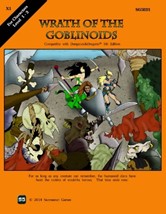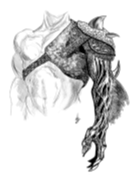 Sacrosanct Games is another publisher who produces old-school style adventures that are now releasing adventures for D&D 5E; their initial release is a conversion of an adventure they’d previously released for both the AD&D and Altus Adventum system. At present, it is only available in pdf.
Sacrosanct Games is another publisher who produces old-school style adventures that are now releasing adventures for D&D 5E; their initial release is a conversion of an adventure they’d previously released for both the AD&D and Altus Adventum system. At present, it is only available in pdf.
Wrath of the Goblinoids is an adventure for first level characters. The primary hook of the adventure is that the players are the goblins, seeking a new home after humans destroyed their old homes. Playing characters who are monsters has been done before, but it is good to see that concept explored further. Roderic Waibel, the author of this adventure, suggests using old PCs of the players as cameo NPCs in the adventure, relating their adventures to the events that underpin this story. It’s a great idea.
As the new edition of D&D doesn’t have rules for monstrous PCs yet, the adventure provides short descriptions of several humanoid races that could be used: Bugbear, Gnoll, Goblin, Hobgoblin, Kobold, Lizardfolk, Orc, and a brand new race, the Yokai, which are described in full in an appendix. The racial abilities in these descriptions are taken directly from the racial traits of the monsters in the Monster Manual. Unusually, the ability score modifiers total only +2 – it’s rather odd to see the Orc gaining only +1 Str and +1 Con when compared to the Half-Orc’s statistics in the Player’s Handbook. There is more of an emphasis on getting interesting races quickly ready for play rather than seeing that they’re all balanced. I personally don’t find this too much of a problem, but I wouldn’t be designing a campaign around players using these races. Instead I’d use them as alternative races for this adventure and its sequel only.
The writing style of the adventure is not polished, with several word choices and phrasings that are poor. “For the majority of your life, the greatest danger to you has been from rival tribes, inside politics, or just plain living in the harsh conditions of the badlands where your villages are scattered.” The text really needs additional editing.
The adventure consists of three scenarios.
The first scenario has the characters seeking a new home for their tribe in the mountains. This scenario uses a hex map of the mountain valleys (similar to that used in the TSR classic adventures S3 Lost Caverns of Tsojcanth and WG4 Forgotten Temple of Tharizdun) with encounter areas scattered around the map: typically at intersections or at the ends of the paths. Characters may not cross the mountains and must stick to the paths. The encounters give a nice mix of combat and negotiation opportunities, along with a few tricks. Actually mapping the valleys and passes is likely to be very annoying for your players; I speak from experience here from having used similar maps in the past.
The second scenario involves the characters exploring a cave complex that will become their new lair. There are 18 encounter areas here, mostly combat encounters, but with a few traps and tricks as well. Overall, there’s nothing particularly special about the encounters, although the presence of a dwarven mine (still worked by dwarves) at the bottom of the caves allows the players to actually feel like monsters, something there’s been little of so far.
The final scenario has the party defending their new home against an incursion by adventurers. This is a very short scenario, taking up only a page, with the bulk of the actions of the adventurers dependent on how the DM sees fit to handle it. The adventurers are given basic statistics and not the full suite of abilities due to their classes, which I appreciate.
Monster statistics are given in short summaries of generally 4-6 lines; special abilities tend to be noted rather than spelt out, so you will need reference to the Monster Manual or the new monsters section in the back of the book to make full sense of some of them. I’m not entirely sure what the letters “ea” represent after the numbers of monsters appearing. Sometimes, special abilities aren’t noted at all: the swarm of rats stat-block, for instance, makes no mention of its numerous resistances and special abilities.
 The adventure also has a number of magic items. I was puzzled by the reference to the potion of greater healing until I found its description in the Hoard of the Dragon Queen Online Supplement; all of these references will become a lot easier once the full D&D 5E is out!
The adventure also has a number of magic items. I was puzzled by the reference to the potion of greater healing until I found its description in the Hoard of the Dragon Queen Online Supplement; all of these references will become a lot easier once the full D&D 5E is out!
The appendices of the book contain the Yokai race, six new monsters and nine new magic items. There are a few obvious editing flaws. For instance, the Potion of Resist Fire grants “damage resistance to the drinker for a duration of 2d4 minutes.” Obviously it should give fire resistance, but that text seems to have been left out. Meanwhile, some descriptions are quite vague – what does it mean for a prosthetic arm to have Strength 18? How does that work in-game? It is very old-school in nature to let the DM figure that out for themselves. The Stone Guardian has “infrared vision” – again, how does that work? At times, there’s an uncertain grasp of the new rules. (Surprises 1-2 on d4? Surely you just give that creature a good Stealth skill and let the player’s choices in character creation and exploration matter!)
The artwork in the book ranges from “not that great” to “really good”; I really like the pictures of the unique magic items, for instance. I find the cover art to be one of the weaker pieces in the book. The formatting of the book evokes the older D&D books, particularly of the Basic range, but has a few issues, especially when the statistics of the Granite Snake are split over two non-facing pages. The maps are excellent and the wilderness map is far, far clearer than that in Forgotten Temple of Tharizdun.
Looking over the adventure as a whole, I find it disappointing. It’s a perfectly serviceable wilderness and dungeon crawl, but it doesn’t really do anything special to cement the fact you’re playing goblins or other evil humanoids. The adventure does describe the major humanoid and human settlements nearby, which sets up some nice tensions and potential for future adventures, but this particular adventure is lacklustre. A sequel to this adventure, Payback, has been released, so it will be interesting to see if higher-level goblins can have a more interesting adventure.

2 thoughts on “Adventure Review: Wrath of the Goblinoids”